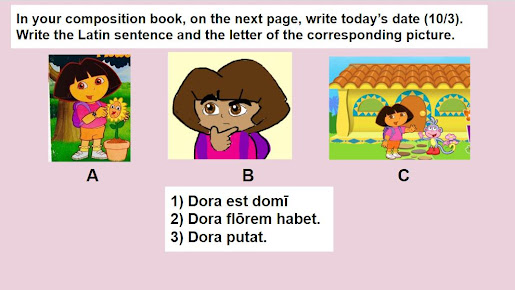(This blog post is a continuation of a series on literacy in the language classroom)
I have been asked a number of times why I have not yet written a Latin novella for students. Prior to April 2024, my response would have been , "I have no idea where to start or what to write about. I do not fully know what truly characterizes a novice reader for beginning L2 learners. While I do understand the concept of sheltering vocabulary, not grammar, and I do implement it with my own students when I create readings for them, the difference is that these readings are for my students, not the Latin student community as a whole."
However, I have a completely different mindset now after reading several of the novice level Spanish novellas which Margarita Perez Garcia has written. For someone like me with very little knowledge of Spanish, that was such an incredible learning experience for me (see blog post here). Moreover, I am blown away and honored that Margarita left a lengthy comment on that post thanking me for what I had written and then explaining her thought processes in writing her novellas (read her comments at the bottom of the post - they are a goldmine of knowledge!).
In her About the Author section, Margarita notes that she "write(s) fiction and non-fiction in Spanish that beginners and struggling readers can read" and that she is "passionate about supporting beginning Spanish learners in their reading journey." I like that description very much, because it truly shows her heart, and Margarita's novellas definitely reflect that vision. So if I were to write a Latin novella, writing one which "beginners and struggling readers in Latin can read" would be my primary goal - one which would be geared towards Novice Low Latin students.
To achieve this, I would do the following:
- Keep a low overall head word count, yet facilitate continued exposure of this focused vocabulary, i.e., shelter vocabulary.
- Use short, simple sentences, which consist of predictable repetitive patterns of word chunks and sentence/grammatical patterns - these are characteristics found in the majority of Novice Low L2 readers, including English.
- Include compelling subject matter and characters which create an emotional connection to readers.
- Write the text not as paragraphs but as individual sentences which are formatted on the right margin of the page. The Foundation for People with Learning Disabilities suggests "Text should always be aligned on the right hand side of the page, and images should be aligned on the left hand side of the page [to help struggling readers]." Margarita Perez Garcia does this in her novice-level novellas - now I know why!
- Implement other Easy Read standards (again from Margarita Perez Garcia):
- No more than 15 words per sentence.
- One idea per line, one sentence per line and if the sentence must break, then break it at a natural "breathing point" where it makes sense.
- Include illustrations which can serve as additional input for text.
- Maybe use Roman culture as its background. While I understand that L2 novellas are a great way to embed and to teach culture, quite often I do get tired that Latin readings are stuck in ancient times. I guess my SALVI, spoken-Latin background is screaming, "You do realize that Latin is still used communicatively to talk about today's modern world and is not bound to the first century!"













